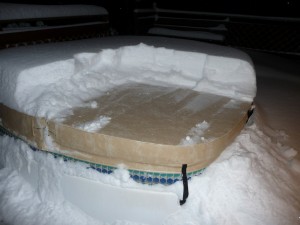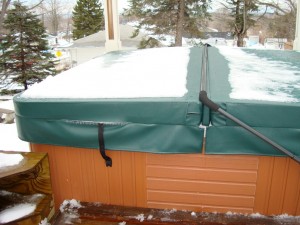When you are trying to figure out which cover will be best for you, there are many points to consider. In this post, the Pros will present in great detail, the critical cover components for environments where insulation is by far the most important feature for the replacement hot tub cover.
If the spa is kept hot continuously, the properly insulating cover will help save both the environment and your operating costs. This is true even if your particular location does not drop to below zero temperatures. Heat loss from the spa increases the carbon footprint of operating your hot tub. In the US, 70% of all electricity is created by burning coal. Reducing your use of electricity, which the proper spa cover can easily do, will save both the ecology and will dramatically reduce the size of your heating bill.
The lid is the most important factor in the overall ability of the spa and cover to retain the heat. Some spa manufacturers take great care to insulate the inside of the spa cabinet to help with heat retention. While this is important, the natural tendency of heat is to rise and the only thing standing in the way of the heat escaping is, you guessed it, the hot tub cover.
The key factors in hot tub covers that affect the cover’s ability to keep the heat in, are the cover thickness, the fold or hinge area across the cover, and the fit of the cover as it sits on the top acrylic lip of the spa. Below, the Pros will discuss each area in detail.
Cover Thickness – Spa covers have a rating, called the R-value, that is a measure of the cover’s ability to insulate and keep the heat inside the spa. The higher the R-value, the greater the insulating ability. The thickness of the cover is the most important factor in the calculation of the R-value, due to how the R-value is calculated. The R-value is calculated, in part, by multiplying the Thermal Resistance Value (R) of the foam times the thickness in inches. For example, a 4″-2″ tapering spa cover with 1.0# density foam cores has an average thickness of 3 inches. To calculate the R-value of the foam at 40 degrees Fahrenheit we multiply the factor of the 1.0# foam times the average thickness of 3 or 4.17 X 3 = R-12.51. To contrast, a 6″-4″ tapering cover is R-20.85. In summary, a 6″-4″ cover has an R-value 167% greater than the 4″-2″ cover.
The Cover’s Fold – Every spa cover is made to fold in half, for ease of removal and storage. The cover is constructed in two halves, with each half containing a solid foam core that gives the cover its strength and provides most of the insulation. When these foam cores are slid into the vinyl skin, the cover assembly is complete. In order for the cover to fold over and to work with most cover lifter or cover removal systems, there is a gap between the foam cores of between one and two inches. This gap runs the width of the cover and can comprise the surface area of a basketball that has no insulation! At each end  of the fold there will be steam stopper pillows, but they are typically around 3 – 5 inches long and serve only to plug the gap between the panels above the acrylic lip of the tub. Note the end of the steam stopper pillow in this photo, under the cover lifter bar. This leaves the remaining distance across the spa uninsulated except for the vinyl that provides the hinge. As this image shows, heat WILL escape through this area like a chimney, and has caused the ice to melt.
of the fold there will be steam stopper pillows, but they are typically around 3 – 5 inches long and serve only to plug the gap between the panels above the acrylic lip of the tub. Note the end of the steam stopper pillow in this photo, under the cover lifter bar. This leaves the remaining distance across the spa uninsulated except for the vinyl that provides the hinge. As this image shows, heat WILL escape through this area like a chimney, and has caused the ice to melt.
The best insulating covers can be made with an extra piece of foam to fill this void and complete the insulation across the top of the cover. The Pros highly recommend adding this extra foam as the cost is typically small and the potential savings is typically large. This extra foam lives in a vinyl sleeve that is sewn into the hinge on the bottom of the cover so you will not be able to see it unless the cover is open. It is called something like a continuous hinge seal or long steam stopper by the various manufacturers. Adding this foam will add R-9 to the insulation value of the cover.
The Cover’s Seal to the Hot Tub Lip – Like the lid on a pot of boiling water, the hot tub covers seal to the top acrylic lip of the hot tub is critical to keeping the heat in. The best lids are available with an option to have a perimeter of soft foam installed inside the vapor barrier. This soft foam allows the cover to settle down onto the acrylic lip and form a much better seal. The Pros have heard from clients with this configuration and they state there is a great swooshing sound when the cover is opened as it is almost air tight. This type of seal can be even more important for spas with raised control panels or speakers, but will benefit anyone looking for the greenest spa cover.
As always, should you have any additional questions, use the Ask the Pros or the Contact The Pros links at the top of this page.
Happy Tubbing!
Ethel Elliott


